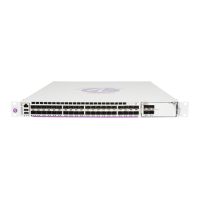Interface Configuration
7750 SR Interface Configuration Guide Page 255
Configuring LAG Parameters
LAG configurations should include at least two ports. Other considerations include:
• A maximum of 64 ports (depending on IOM type, chassis-mode and lag-id) can be
included in a LAG. All ports in the LAG must share the port characteristics inherited from
the primary port.
• Autonegotiation must be disabled or set limited mode for ports that are part of a LAG to
guarantee a specific port speed.
• Ports in a LAG must be configured as full duplex.
The following example displays LAG configuration output:
A:ALA-A>config>lag# info detail
----------------------------------------------
description "LAG2"
mac 04:68:ff:00:00:01
port 1/1/1
port 1/3/1
port 1/5/1
port 1/7/1
port 1/9/1
dynamic-cost
port-threshold 4 action down
----------------------------------------------
A:ALA-A>config>lag#
Configuring BFD on LAG Links
BFD can be configured under the LAG context to create and establish the micro-BFD session per
link after the LAG and associated links have been configured. An IP interface must be associated
with the LAG or a VLAN within the LAG, if dot1q encapsulation is used, before the micro-BFD
sessions can be established.
Complete the following steps to enable and configure BFD over the individual LAG links:
• Enable BFD within the LAG context, which also enters the CLI into the BFD context
• Configure the address family which is to be used for the micro BFD sessions. Only one
address family can be configured per LAG
• Configured the local-IP address to be used for the BFD sessions
• Configure the remote-IP address to be used for the BFD sessions
When configuring the local and remote IP address for the BFD over LAG link sessions, the local-
ip parameter should always match an IP address associated with the IP interface to which this
LAG is bound. In addition, the remote-ip parameter should match an IP address on the remote

